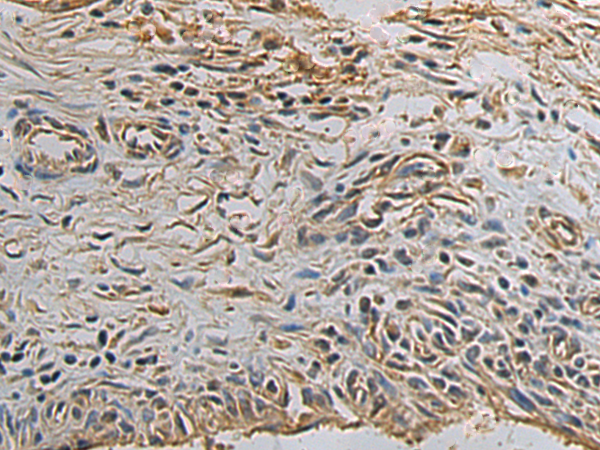
| WB | 咨询技术 | Human,Mouse,Rat |
| IF | 咨询技术 | Human,Mouse,Rat |
| IHC | 1/50-1/200 | Human,Mouse,Rat |
| ICC | 技术咨询 | Human,Mouse,Rat |
| FCM | 咨询技术 | Human,Mouse,Rat |
| Elisa | 1/5000-1/10000 | Human,Mouse,Rat |
| Aliases | EXT; LGS; TTV; LGCR; TRPS2 |
| Host/Isotype | Rabbit IgG |
| Antibody Type | Primary antibody |
| Storage | Store at 4°C short term. Aliquot and store at -20°C long term. Avoid freeze/thaw cycles. |
| Species Reactivity | Human, Mouse |
| Immunogen | Fusion protein of human EXT1 |
| Formulation | Purified antibody in PBS with 0.05% sodium azide and 50% glycerol. |
+ +
以下是关于EXT1抗体的3篇参考文献及其摘要概括:
---
1. **文献名称**:*Mutations in the EXT1 and EXT2 genes in hereditary multiple exostoses*
**作者**:Wuyts W, et al.
**摘要**:该研究分析了遗传性多发性骨软骨瘤(HME)患者的EXT1和EXT2基因突变,通过免疫印迹和免疫组化技术使用EXT1抗体检测突变对蛋白质表达的影响,发现EXT1功能缺失导致硫酸乙酰肝素合成异常,进而影响软骨发育。
---
2. **文献名称**:*Heparan sulfate proteoglycans and cancer metastasis: roles of EXT1 and heparanase*
**作者**:Sanderson RD, et al.
**摘要**:研究探讨了EXT1介导的硫酸乙酰肝素(HS)在肿瘤转移中的作用,利用EXT1抗体发现其低表达与卵巢癌侵袭性增强相关,提示EXT1可能通过调控细胞外基质抑制肿瘤转移。
---
3. **文献名称**:*Autoantibodies against EXT1 in systemic lupus erythematosus: association with disease activity*
**作者**:Soulitzis N, et al.
**摘要**:首次报道系统性红斑狼疮(SLE)患者血清中存在抗EXT1自身抗体,通过ELISA和蛋白质印迹法验证,发现其水平与疾病活动度正相关,提示EXT1可能参与自身免疫反应的分子机制。
---
4. **文献名称**:*EXT1 regulates Wnt/β-catenin signaling in glioma progression*
**作者**:Deng Y, et al.
**摘要**:研究显示胶质瘤中EXT1表达下调通过减弱Wnt信号通路抑制肿瘤生长,使用EXT1抗体进行免疫沉淀实验,证实其与Wnt受体复合物的相互作用,为靶向治疗提供新思路。
---
这些文献涵盖了EXT1抗体在遗传病、癌症及自身免疫疾病中的研究应用。
The EXT1 antibody targets the exostosin-1 (EXT1) protein, a critical enzyme in heparan sulfate proteoglycan (HSPG) biosynthesis. EXT1. encoded by the *EXT1* gene on chromosome 8q24. forms a heterocomplex with EXT2 to catalyze the polymerization of heparan sulfate chains. These chains regulate cell signaling, adhesion, and matrix interactions. Mutations in *EXT1* are linked to Hereditary Multiple Osteochondromas (HMO), a disorder characterized by benign bone tumors.
EXT1 antibodies are widely used in research to study HSPG-related pathways, including Wnt, FGF, and Hedgehog signaling, which are crucial in development and cancer. They aid in detecting EXT1 expression via techniques like Western blot, immunohistochemistry (IHC), and immunofluorescence (IF), helping to correlate protein levels with diseases. In cancer biology, reduced EXT1 expression is observed in hepatocellular carcinoma, leukemia, and breast cancer, suggesting a tumor-suppressive role.
Clinically, EXT1 antibodies assist in diagnosing HMO and differentiating osteochondroma subtypes. They also explore therapeutic targets, as HSPG dysregulation impacts tumor metastasis and angiogenesis. Commercial EXT1 antibodies are typically monoclonal or polyclonal, validated for specificity in human and model organisms. Challenges include cross-reactivity with EXT2 due to structural homology, necessitating careful validation. Overall, EXT1 antibodies are vital tools for understanding extracellular matrix biology and disease mechanisms.
×